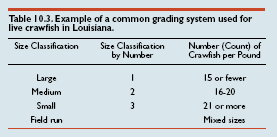Whether from aquaculture or the natural fishery, the supply of live crawfish is highly seasonal, with peak of the harvest occurring from March through June (Figure 1). Historically, most of the domestic supply has been consumed in Louisiana and surrounding southern states, particularly Texas, the Mississippi Gulf coast and the Florida panhandle (Figure 2). Because of restricted geographical areas of production, seasonal supply, unstable prices and cultural mores, crawfish sales nationally have been limited, but have increased in recent years.
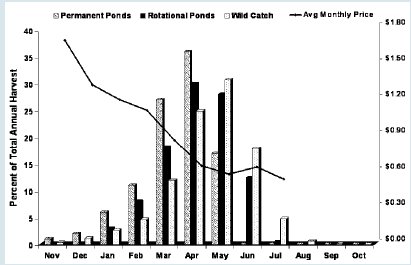
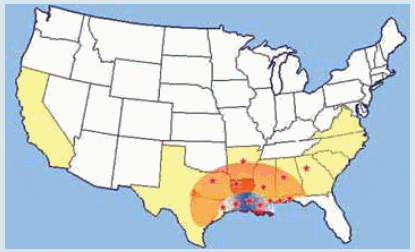
Product Forms
Live crawfish
All crawfish are marketed live by farmers, and live crawfish comprise most of the final sales to consumers. Producers of large crawfish have a competitive advantage, especially when the supply of live crawfish exceeds demand. In times of oversupply, generally the larger crawfish remain in the live market and smaller crawfish are processed for meat. Most producers sell live crawfish to a primary wholesaler (Figure 3) or a processor, although a limited volume is sold directly to retail stores, restaurants and consumers. In Louisiana, red swamp crawfish have higher consumer appeal in the live market than white river crawfish, although this distinction is usually not made outside of traditional southern Louisiana markets.
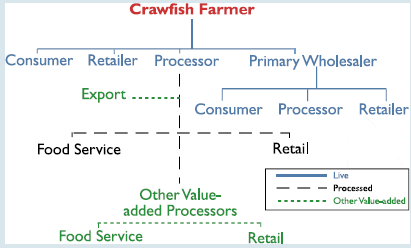
Highest demand by retail consumers and restaurants is on weekends, even in Louisiana, with limited retail sales early in the week. The live product, with its restricted shelf life of no more than several days, largely dictates harvesting schedules and market plans. Shelf life of the live product also effectively limits regional and national distribution.
Whether served in households or retail outlets, live crawfish are typically boiled (or steamed) and consumed hot and fresh in a festive atmosphere. Crawfish are not considered a staple food; rather, they are generally associated with social occasions, and no food exemplifies the Cajun cultural atmosphere like fresh, boiled crawfish coupled with its requisite condiments of spicy vegetables and cold beverages.
Processed and prepared products
When crawfish are abundant or when live markets become saturated, a portion of the annual crop is processed and sold as fresh or frozen abdominal or “tail” meat. The most popular processed product is cooked, hand peeled and deveined meat that is usually sold in 12-ounce or 1-pound packages (Figure 4). Tail meat may be packed with or without hepatopancreatic tissue (in Louisiana frequently referred to as “fat”), which is an important flavoring condiment in Louisiana cuisine and is savored for its distinctive rich flavor. The smaller size classes of crawfish are usually those processed for the tail meat market, leaving the larger individuals for the more profitable live market.
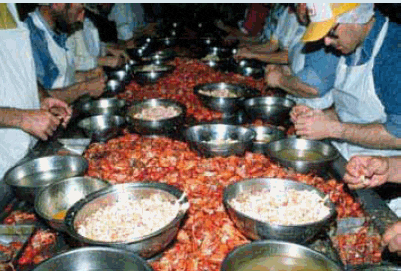
The abdominal meat yield for cooked crawfish is, on average, about 15 per cent of live weight, but meat yield varies with factors such as sexual maturity and size. Immature crawfish generally yield 4 per cent to 5 per cent more meat than mature individuals because they have smaller claws and thinner shells. Cooking time and peeling technique can also influence meat yield because all processing is by hand. Early in the production season (November-March) when a high percentage of the crawfish are immature, meat yield can be as high as 22 per cent to 23 per cent. Late in the season (April-July) when most crawfish are mature and have heavier exoskeletons and large claws, meat yield can be as low as 10 per cent to 12 per cent of body weight. Abdominal meat is used in diverse ways and can be an appropriate substitute in many shrimp recipes. The amount of crawfish processed for tail meat in Louisiana varies annually, but since the introduction of inexpensive procambarid crawfish meat from China, it is estimated that less than 10 per cent of the annual crop is now processed for meat.
Another product form is cooked whole crawfish, usually served fresh and hot, with small volumes also sold as frozen product later to be warmed and served. Traditionally, crawfish in the southern United States are cooked with red pepper-based spices/seasonings, often with onions, potatoes and corn that complement the meal. The consumer extracts the edible portions of the whole crawfish by hand (Figure 5).
Increasing in popularity in Louisiana, and within the range of delivery for live crawfish outside of Louisiana, are retail outlets and restaurants serving hot, boiled crawfish. Small, seasonally “take-out” outlets (Figure 6) have developed wherever live crawfish can be readily obtained, and many businesses also cater boiled crawfish to large groups, parties and festivals using custom boiling rigs (Figure 17).
Prepared frozen crawfish dishes, although still only encompassing a small portion of total sales, have helped increase the distribution of processed abdominal crawfish meat through value-added products.
Marketing Influences
Marketing of domestically produced crawfish has been complicated in recent years by imports of crawfish products. Millions of pounds of imported frozen processed meat and whole boiled procambarid crawfish, principally from the Peoples Republic of China, are imported into the US annually (Figure 8). Although a tariff has been imposed by the United States Department of Commerce on much of the imported Chinese crawfish meat, damage to the US industry has occurred. Prior to Chinese imports over 100 licensed crawfish processors existed in Louisiana. Today, the number of processors number in the low 30s and this has lead to dramatic reduction in processing (peeling) capacity in Louisiana. As a consequence, each year thousands of tons of smaller crawfish are not harvested for lack of adequate live markets and processing infrastructure.
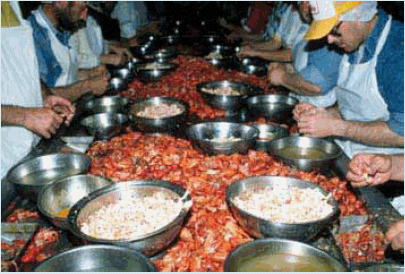
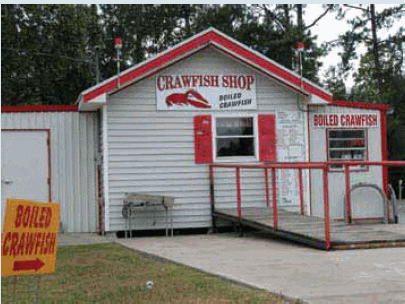

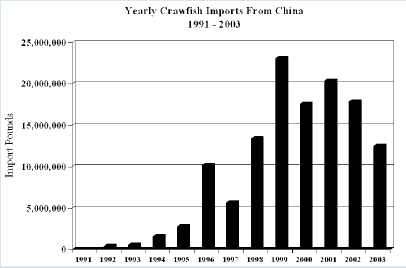
Although demand for crawfish in Louisiana is high, and markets are expanding in adjacent states, on a national basis, crawfish are in direct competition with products such as shrimp, prawns, lobster and crabs. Unlike Louisiana, the public in other states have historically and culturally not consumed crawfish. Nonetheless, crawfish imports provide for year-round availability and more stable prices, which reportedly have had some positive influences in development and expansion of new markets for crawfish products outside of traditional crawfish consuming areas. The growing popularity of southern Louisiana “Cajun” and “Creole” cuisine throughout the US offers excellent opportunity for expanded market development and sale of both live and processed domestically produced crawfish products in the southern US and elsewhere.
Pricing
Supply and demand relationships are reflected in price variations from year to year and from week to week during the crawfish harvest season. In Louisiana, average annual pond bank price paid to producers from 1997 through 2005 has averaged between $0.55 and $0.82 per pound, when annual supply ranged from 70 to 85 million pounds, except in 2000 and 2001 when low supply from both aquaculture and the wild crop pushed average statewide wholesale prices over $1.24 per pound (Table 1). Seasonally, prices to producers are highest in winter and early spring when supply is relatively low (Figure 1 and Table 2). Prices decline significantly in late spring and summer when supply peaks and the supply and demand for other locally produced fresh seafoods such as shrimp and crabs increase. In Louisiana, price declines as high as 40 per cent to 55 per cent for “field run” crawfish can occur within several weeks during peak production (April and May) if crawfish quality (usually size) decreases, but the drop in price for larger crawfish is usually substantially less. In recent years, large crawfish have commanded a wholesale price 2 to 3 times higher than paid for medium to small crawfish.
Although prices for live crawfish are relatively uniform among wholesale buyers from day to day or week to week, no single buyer or group of buyers exerts excessive control over pond-bank prices. But when crawfish supplies are high, wholesalers and processors do have the ability to exert price leverage on producers, and this is usually based on their ability, or inability, to move large volumes of crawfish in the live market. Some buyers offer premium prices for their larger, more loyal or more consistent suppliers.
Although wholesale prices for peeled crawfish tail meat are not published, prices typically track the price of live product and, as a “rule of thumb,” the wholesale price of a pound of tail meat is 10 to 12 times higher than the wholesale price of a pound of live crawfish.
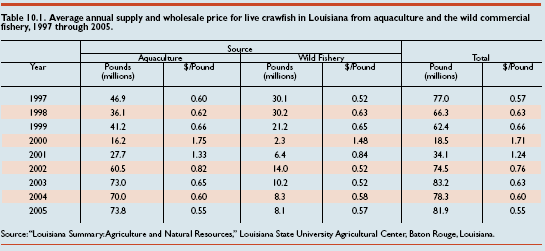

Production Strategies for Identified Markets
A crawfish producer should be familiar with potential markets, both wholesale and retail, and match production to estimated needs. Since crawfish are harvested several times per week, reliable buyers are paramount to a farmer’s success. Direct sales to retail customers by farmers are not particularly high in large production areas like southern Louisiana. Therefore, most large producers in these areas must sell most of their harvest to wholesale buyers and processors. Small-scale crawfish producers outside of Louisiana have few established and knowledgeable wholesalers who are experienced in marketing live crawfish. Many small-scale producers, however, have successfully developed markets for both direct retail sales to consumers and to retail seafood establishments.
Occasionally, harvesting schedules and strategies must be adjusted to accommodate available markets. Buyers may prefer to have product delivered only on certain days, such as Thursday through Sunday. Additionally, market demand for crawfish early in the season may allow for various sizes of crawfish to be sold with little problem, but when crawfish supplies are more abundant, trapping strategies may need to be adjusted to maximize crawfish sizes, even at the expense of overall yield. Planning and good communication with potential buyers early in the season can allow trapping strategies to be developed that respond to market preferences and improve a producer’s competitive position.
Regulations and Permits
Various permits may be required to market crawfish, such as wholesale or retail fish distributor’s license, or to transport them across state lines. Permits are specific for each state. Imports of live non-native crawfish are restricted or forbidden in a number of states, especially where there are concerns over establishment and competition with native species. Before shipping live crawfish, always verify regulatory requirements in the receiving state, or states in which crawfish are being transported, to avoid serious legal problems.
In Louisiana, live haulers are usually required to possess permits or licenses to transport crawfish, depending on whom their crawfish are being purchased from or sold to. These may include municipal or parish permits as well as a state transport license and seafood wholesale/retail dealer’s license. For interstate shipments of live crawfish, pass-through states and the receiving state also will likely have license requirements.
Transport and Storage
Storage and transport of live crawfish is unusual in that they are not transported in water, but rather consolidated in plastic mesh sacks (Figure 9). Sacks hold about 35 to 45 pounds of crawfish depending on how tightly the trapper chooses to pack them. This method is preferred over more rigid containers such as totes (Figure 10) because crawfish can be packed in the sacks in a manner that prevents damage from pinching, which can happen when animals are not sufficiently restricted.
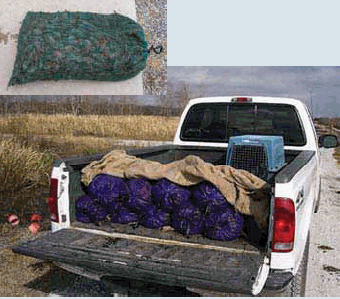
To minimize crushing, sacks should not be packed too tightly, but sufficiently tight to restrict crawfish movement. Sacks of live crawfish can be transported in open bed trucks for short distances, but sacks should be covered with a tarp to minimize drying of gills. Wholesalers or jobbers haul sacks of live crawfish over long distances, or in larger quantities, in insulated trucks, with or without refrigeration (Figure 11). Crushed ice is placed over the sacks in nonrefrigerated trucks and, in some cases, refrigerated trucks, to reduce crawfish metabolism and maintain a high level of humidity, which increases shelf life of live crawfish.
High survival rate during live transport begins by insuring crawfish are harvested from ponds with good water quality. Live crawfish should be transported to on-the-farm coolers or to the terminal market as soon after harvest as possible. Transport vehicles should be clean and free from petroleum products or other contaminates. If hauled long distance in the harvest boat or transported in an open vehicle, exposure of crawfish to excessive wind and bright sunlight should be minimized by covering the sacks with wet burlap or a tarp. Sacks should not be stacked so high that crawfish in the bottom sacks are crushed.

Sacks of live crawfish in good physical condition can be held in high humidity coolers at 38 F to 46 F for up to several days prior to peeling or further transport to the terminal destination. Maintenance of gill moisture is crucial for survival of crawfish held in coolers. Gill moisture is usually accomplished by periodic wetting of crawfish and/or placement of wet burlap or ice over the sacks of crawfish. If placed in plastic tote boxes, the top tote should be filled with ice. Melting ice trickles down through the totes to provide the necessary moisture. Placing unchilled crawfish in totes is not recommended because physical damage from pinching by active crawfish may occur.
A relatively small volume of live crawfish is shipped in sacks by air-freight throughout the United States in insulated seafood shipping boxes containing frozen gel packs. During warm weather, crawfish shipped by air freight should be cooled overnight prior to shipping.
Purging and Cleaning
To provide a more appealing product for live markets, a small number of producers have adopted the practice of “purging” crawfish before selling them. This requires that crawfish be confined in water or very humid environments where food is withheld for 24 to 48 hours. This process cleans the exoskeleton of mud and debris and eliminates or reduces digesta in the intestine (Figure 12), which consumers may find unappealing. This method should not be confused with the practice of immersing crawfish in salt water immediately before boiling, which is not effective in evacuating the gut and is little more than an external wash.
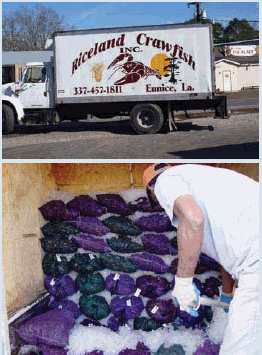
To facilitate removal of the intestinal contents, crawfish are commonly held in tanks within specially constructed boxes or baskets (Figure 12) that are usually suspended in water. Recommended loading rate is about 1.5 pounds of crawfish per square feet of submerged surface area with adequate aeration and water exchange. Equally effective, but seldom used, is a water spray system where crawfish are held in shallow pools of water (1/2-inch deep) under a constant spray or mist. Holding crawfish in aerated vats or purging systems under crowded conditions for more than 24-48 hours is not recommended because of the possibility of excessive mortality. Though purging increases the cost of the product, purged crawfish have high consumer acceptance, particularly outside of traditional Louisiana markets. Some people who have eaten crawfish for many years are accustomed to nonpurged crawfish and do not find them objectionable; nonetheless, many would probably prefer purged product if cost was reasonable.
Although the current market for purged crawfish is small from a lack of public awareness and price differences (15 per cent to 25 per cent higher), purging has contributed to repeat sales and loyalty to certain producers or distributors. Mortality during purging is the largest contributor to increased prices, but research has recently demonstrated that shorter purge duration (12 hours) can be nearly as effective and contributes significantly to less mortality.
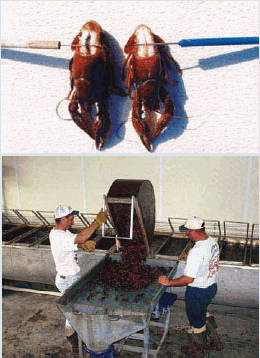
The external surfaces of crawfish, which can be fouled and/or stained, are reasonably cleaned during purging. Abrasive actions of crowded crawfish rubbing against one another effectively “polish” the shells. For nonpurged animals and excessively stained batches of crawfish, however, additional cleaning is sometimes accomplished prior to cooking. External cleaning of the carapace of live crawfish with food-service chemicals (ascorbic or citric acid and baking soda) to enhance appearance and increase marketability is becoming increasingly common.
Grading
Crawfish markets have changed considerably since the mid-1980s when crawfish were sold without consideration of size. Development of an export market in Scandinavia in the late 1980s for crawfish 15-count (number per pound) or larger, first provided the impetus for size grading. Louisiana’s export markets for crawfish were eventually lost to competition from the Peoples Republic of China, but size grading remained and is widely used in the domestic market. Grading by size is usually not practiced early in the production season when crawfish supply is low and demand is high for crawfish of all sizes, but as the volume of crawfish increases in early spring size grading becomes a standard practice for servicing the market demand for large crawfish. Nearly all grading occurs at wholesale outlets or processing plants, using modified vegetable graders or custom-made graders (Figure 13).
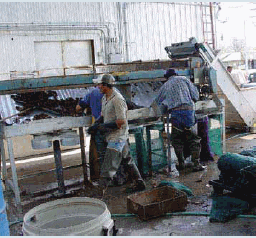
At present, no uniform size and grade standards exist for the crawfish industry as with other seafoods, and this to some degree hinders out-of-state market development and expansion. Based on a number of production and marketing conditions, crawfish are typically graded into two or three size classes. Generally, the largest crawfish are sold to specialty restaurants, and the smaller ones are processed for tail meat or blended with larger individuals for large volume sales. One example of a commonly used grading system for crawfish in Louisiana is shown in Table 3. Other grading standards are used by various crawfish wholesalers depending on their markets.
